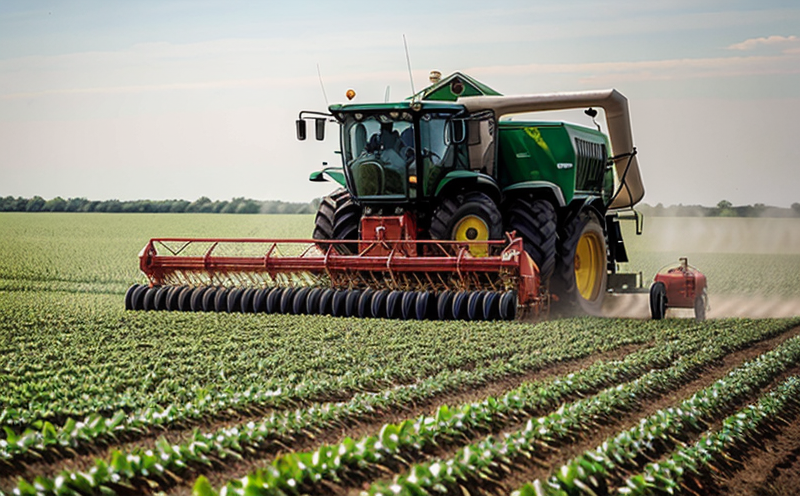Canopy Temperature Depression Testing
In agriculture and forestry testing, canopy temperature depression (CTD) is a critical parameter that reflects the efficiency of photosynthesis in crops. By measuring CTD, we can assess how well plants utilize sunlight for energy conversion into biomass. This service is particularly useful for optimizing crop yield and productivity under various environmental conditions.
Canopy temperature depression testing involves monitoring the temperature differences between the air above a plant canopy and within the canopy itself. The difference in temperature indicates the amount of heat absorbed by the leaves, which in turn reflects their photosynthetic activity. This information is invaluable for quality managers, compliance officers, R&D engineers, and procurement specialists who aim to enhance crop performance.
One of the primary tools used in this testing process is a thermal imaging camera capable of detecting minute temperature variations within the canopy. The camera captures images that are then analyzed using specialized software to calculate the CTD values. These values provide insights into how efficiently water and nutrients are being utilized by the plants, which can help in identifying underperforming areas or optimal conditions for growth.
The testing process begins with selecting representative plots within a field or forest area. Specimens are then prepared by ensuring that the canopy is undisturbed to avoid introducing errors into the temperature readings. Once the specimens are ready, the thermal imaging camera is calibrated and positioned to capture images of the entire canopy. The software used for analysis must adhere strictly to international standards such as ISO 13495-2:2016, which ensures consistency in measurement.
The results from CTD testing provide a comprehensive picture of crop health and productivity. These data can be used to adjust irrigation schedules, optimize fertilization practices, and even modify planting densities. For instance, if the CTD values indicate that certain parts of the canopy are overheating due to insufficient water or nutrients, corrective actions can be taken immediately.
Another significant benefit of this testing method is its ability to predict future yields based on current conditions. By understanding how well the plants are utilizing available resources, farmers and researchers can make informed decisions about resource allocation. This not only enhances productivity but also contributes to more sustainable agricultural practices by minimizing waste and maximizing efficiency.
Furthermore, CTD testing is particularly useful in comparing different varieties of crops or even different farming techniques. For example, a study might compare the CTD values between two types of wheat grown under identical conditions except for one variable such as soil type or irrigation method. Such comparisons can lead to valuable insights into which factors most significantly impact crop performance.
It's important to note that while CTD testing provides valuable data, it should be used in conjunction with other tests and observations. For instance, measuring leaf area index (LAI) alongside CTD can give a more holistic view of the canopy environment. Similarly, combining CTD results with soil moisture content readings can help identify whether issues are primarily related to water stress or another factor.
Applied Standards
- ISO 13495-2:2016: This international standard provides guidelines for the measurement of canopy temperature depression, ensuring consistency and accuracy in results across different locations.
- ASTM E2786-18: Another relevant standard that deals with thermal imaging methods used in agricultural testing, this document helps ensure reliability when using thermal cameras for CTD measurements.
International Acceptance and Recognition
The use of canopy temperature depression testing is widely recognized internationally. Many countries have adopted these practices as part of their agricultural research programs, recognizing the benefits in terms of improved crop yields and more sustainable farming methods.
For instance, the European Union has been a pioneer in promoting precision agriculture techniques that include CTD monitoring. Similarly, organizations like the Food and Agriculture Organization (FAO) of the United Nations have endorsed this technology as part of their efforts to combat global food insecurity.
The testing method is also recognized by various academic institutions around the world who conduct research on crop physiology and environmental stress responses. These studies often incorporate CTD measurements to better understand how different factors affect plant growth and development.
Use Cases and Application Examples
- Crop Stress Diagnostics: Detecting early signs of water or nutrient stress in crops through CTD measurements can help prevent significant yield losses.
- Breeding Programs: Comparing the CTD values between different plant varieties during breeding programs allows for more efficient selection processes based on photosynthetic efficiency.
- Irrigation Management: Implementing real-time monitoring systems that use CTD data can optimize irrigation schedules, reducing water usage and improving resource management.
- Disease Detection: Changes in CTD patterns may indicate the onset of certain diseases or pests, allowing for early intervention measures to be taken.





